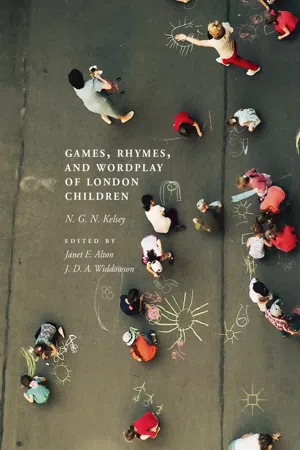As many others have pointed out, the procedure that takes place before a game is of great importance for children. Sometimes it seems to take up more time and arouse more excitement than the actual playing of the game itself. Even before the playground is reached there may already have been arguments and decisions made as to the games to be played and those who are to take part:
“When we play with the boys we always decide up in the classroom. We go out in the playground and get all the boys together and then we ask them. If they don’t want to play (with us) we find something else to play.” girl, 10, Dalston 1983.
“When we play games we all suggest what to play. Sometimes one of the girls suggests what to play, and if we like it we’ll play it but if we don’t then we play what we like.” boy, same class.
In Inner London the integration of boys’ and girls’ playgrounds did not take place until the 1970s. Separate playgrounds for boys and girls may still have existed when I was collecting children’s lore, but I did not come across any in my visits. As already noted, Fr. Damian Webb, in his introduction to the one volume collection of Alice Gomme’s Traditional Games (1984, p. 15) regrets the passing of the single sex playground, but although there have been some losses as regards the repertoire of girls’ singing games and the like, I believe the gains socially outweigh any losses.
The problems of integrated games exist much more in some schools than in others, as does the balance between games played separately by boys and girls and those played together. The urge to “put down” the girls is expressed in some schools:
“Sometimes when we ask the boys to play in the class they get a bit moany. They’re always shouting if they don’t want to play a game (if) they think it’s a bit of a girls’ game. Sometimes when we’re in the classroom and we want to play a game with the boys, and the boys want to play a little game with us we surround (sic) all together and make up a game between us so we all like the game.” girl, 11, Dalston 1983.
“Sometimes when we play the games we don’t want the rough boys to play because they start trouble and some of us get hurt.” girl, same class.
Decisions can be taken by the acknowledged leader or boss:
“(_____) always organises our games. He bosses us about and he’s always in charge.” boy, 10, Dalston 1983.
“(_____) sometimes organises the games and sometimes (_____). She tells us what to do. … and if there’s any new ones.” girl, same class.
Another boy modified what the first one had said about the absolute power of the leader:
“When we play a game (_____) decides the game and if we like it we’ll play it, but if we don’t like it he decides another one.” boy, same class.
In some schools there is a completely different approach, and a more democratic spirit prevails:
“Say people want to play ‘Family he’ and other people want ‘Stuck in the mud’, somebody will say, ‘Well, let’s have a vote.’ You say, ‘People who want to play Family he, put your hands up.’ They count how many there are. Then the people who want to play ‘Stuck in the mud’ would put up their hands. The one that had the most hands would win.” girl, 11, Finsbury 1983.
“We vote and sometimes it goes wrong so we change the game. Sometimes we each have an idea and then we pick which is the best. Sometimes we have a vote on which games and the most people that think the games are right, play.” girl, 10, Kentish Town 1983.
It is not always decided by either the autocratic or the democratic method:
“If there’s two games (suggested) we just row about it until we’ve decided the game. Otherwise we go round shouting, ‘Who’s going to play … ?’ whatever game we’re going to play.” boy, 11, Kensington 1984.
“We argue a lot about who’s going to play. If somebody comes along and says, ‘Can I play?’ others may say, ‘No’ or ‘It’s not my game.’ ” girl, same class.
When it is finally settled, by whatever method, what the game is that is going to be played, and who is to take part, it is probably a game where somebody has a particular role to play as seeker or catcher. This person has to be selected and the role is usually one to be avoided, though occasionally it is one to be sought. Some method therefore has to be used to decide who is to be “on it”, “on”, “it” or “he”. All four of these terms are used in Inner London. Sometimes two, or rarely three, different terms can be found in the same school, or were when I made my visits to twenty-one schools between 1982 and 1984. To all intents and purposes “on” is not significant. It seems to be a shortened form of “on it”.
on it I found this term used in fourteen out of twenty-one schools in which:
five used it solely
three used it as well as “he”
five used it as well as “it”
one used it as well as “he” and “it”
he I found this term used in nine out of twenty-one schools, in which:
one used it solely
three used it as well as “on it”
four used it as well as “it”
one used it as well as “on it” and “it”
it I found this term used in eleven out of twenty-one schools, in which:
one used it solely
five used it as well as “on it”
four used ...
